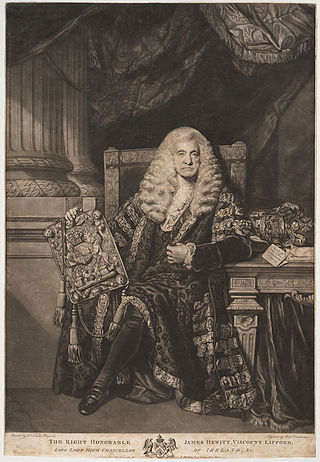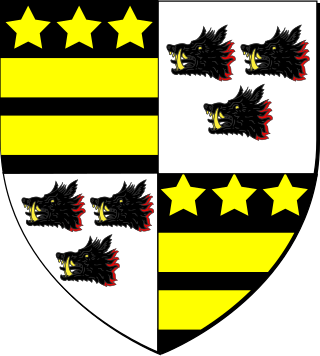Related Research Articles

The titles of Earl of Hertford and Marquess of Hertford have been created several times in the peerages of England and Great Britain.

Marquess of Downshire is a title in the Peerage of Ireland. It was created in 1789 for Wills Hill, 1st Earl of Hillsborough, a former Secretary of State.

Viscount Hood, of Whitley in the County of Warwick, is a title in the Peerage of Great Britain. It was created in 1796 for the famous naval commander Admiral Samuel Hood, 1st Baron Hood. He had already been created a Baronet, of Catherington, in the Baronetage of Great Britain on 20 May 1778, and Baron Hood, of Catherington in the County of Southampton, in the Peerage of Ireland in 1782.

Earl of Gosford is a title in the Peerage of Ireland. It was created in 1806 for Arthur Acheson, 2nd Viscount Gosford.

Earl Erne, of Crom Castle in the County of Fermanagh, is a title in the Peerage of Ireland. It was created in 1789 for John Creighton, 2nd Baron Erne, who had earlier represented Lifford in the Irish House of Commons. He had already been made Viscount Erne, of Crom Castle in the County of Fermanagh, in 1781, also in the Peerage of Ireland, and sat from 1800 to 1828 as an Irish Representative Peer in the British House of Lords. The title of Baron Erne, of Crom Castle in the County of Fermanagh, was created in the Peerage of Ireland in 1768 for his father Abraham Creighton. The Earl was succeeded by his eldest son, the second Earl. On his death the titles passed to his nephew, the third Earl. He was an Irish Representative Peer from 1845 to 1885 and also served as Lord Lieutenant of County Fermanagh during the same period. In 1876 he was created Baron Fermanagh, of Lisnaskea in the County of Fermanagh, in the Peerage of the United Kingdom. This was to allow the Earls to sit in the House of Lords by right, rather than having to stand for election as Representative Peers. An earlier title of Baroness Fermanagh in the Peerage of Ireland was created for Mary Verney on 13 June 1792, but became extinct on her death on 15 November 1810.

Earl of Craven, in the County of York, is a title that has been created twice, once in the Peerage of England and once in the Peerage of the United Kingdom.

Earl of Limerick is a title that has been created twice in the Peerage of Ireland, associated first with the Dongan family, then with the Pery family.

Earl of Clanwilliam is a title in the Peerage of Ireland. It was created in 1776 for John Meade, 1st Viscount Clanwilliam. The Meade family descends from Sir John Meade, who represented Dublin University and County Tipperary in the Irish House of Commons and served as Attorney-General to James, Duke of York. In 1703, he was created a Baronet, of Ballintubber in the County of Cork, in the Baronetage of Ireland. His eldest son, Pierce, the second Baronet, died unmarried at an early age and was succeeded by his younger brother Richard, the third Baronet. Richard represented Kinsale in the Irish Parliament.

Earl of Drogheda is a title in the Peerage of Ireland. It was created in 1661 for The 3rd Viscount Moore.

Earl of Donoughmore is a title in the Peerage of Ireland. It is associated with the Hely-Hutchinson family. Paternally of Gaelic Irish descent with the original name of Ó hÉalaighthe, their ancestors had long lived in the County Cork area as allies of the Mac Cárthaigh clan; they lost out during the times of Oliver Cromwell. One branch of the family converted to the Anglican Church and after inheriting territories through his mother and adding "Hutchinson" to Hely, became the Earl of Donoughmore.

Earl Granville is a title that has been created twice, once in the Peerage of Great Britain and once in the Peerage of the United Kingdom. It is now held by members of the Leveson-Gower family.

Viscount Gage, of Castle Island in the County of Kerry of the Kingdom of Ireland, is a title in the Peerage of Ireland. It was created in 1720 for Thomas Gage, along with the subsidiary title of Baron Gage, of Castlebar in the County of Mayo, also in the Peerage of Ireland. In 1744 he also succeeded his cousin as eighth Baronet, of Firle Place. The titles remain united. The Gage family descends from John Gage, who was created a baronet, of Firle Place in the County of Sussex, in the Baronetage of England on 26 March 1622. His great-grandson, the seventh Baronet, represented Seaford in Parliament. He was succeeded by his first cousin, Thomas Gage, 1st Viscount Gage, the eighth Baronet. He sat as a Member of Parliament for Minehead and Tewkesbury and also served as Governor of Barbados. In 1720, 24 years before succeeding in the baronetcy, he was raised to the Peerage of Ireland as Baron Gage and Viscount Gage. His second son was the military commander the Hon. Thomas Gage.

Viscount Lifford is a title in the Peerage of Ireland. It was created in 1781 for James Hewitt, 1st Baron Lifford, the Lord Chancellor of Ireland. He had already been created Baron Lifford, of Lifford in the County of Donegal, in 1768, also in the Peerage of Ireland. He was succeeded by his son, the second Viscount, who was Dean of Armagh from 1796 to 1830. His grandson, the fourth Viscount, sat in the House of Lords as an Irish Representative Peer from 1856 to 1887. His younger son, the sixth Viscount, was a captain in the Royal Navy. His son, the seventh Viscount, fought in both the Second Boer War and the First World War. He was succeeded by his cousin, the eighth Viscount. He was the son of the Hon. George Wyldbore Hewitt, seventh son of the fourth Viscount. As of 2014 the titles are held by his son, the ninth Viscount, who succeeded in 1987.
Viscount Hampden is a title that has been created twice, once in the Peerage of Great Britain and once in the Peerage of the United Kingdom. The first creation came in the Peerage of Great Britain when the diplomat and politician Robert Hampden, 4th Baron Trevor, was created Viscount Hampden, of Great and Little Hampden in the County of Bedford on 14 June 1776. The title of Baron Trevor, of Bromham, had been created in the Peerage of Great Britain in 1712 for his father, the lawyer Sir Thomas Trevor. Both titles became extinct in 1824 on the death of the first Viscount's second son, the third Viscount.

Baron Carbery, of Carbery in the County of Cork, is a title in the Peerage of Ireland. It was created in 1715 for George Evans, with remainder to the heirs male of his father and namesake George Evans, a supporter of William and Mary during the Glorious Revolution, who had earlier declined the offer of a peerage. After his elevation to the peerage, Lord Carbery represented Westbury in the House of Commons. He was succeeded by his eldest son, the second Baron. He also sat as Member of Parliament for Westbury. His grandson, the fourth Baron, briefly represented Rutland in Parliament. He was succeeded by his uncle, the fifth Baron. On his death, the line of the eldest son of the first Baron failed. He was succeeded by his first cousin once removed, the sixth Baron, who had previously succeeded his father as second Baronet, of Castle Freke. Lord Carbery sat in the House of Lords as an Irish Representative Peer from 1824 to 1845. His nephew, the eighth Baron, was an Irish Representative Peer from 1891 to 1894. As of 2014 the titles are held by the latter's great-great-grandson, the twelfth Baron, who succeeded his father in 2012.
Earl of Clonmell, in the County of Tipperary, was a title in the Peerage of Ireland. It was created in 1793 for John Scott, 1st Viscount Clonmell, Lord Chief Justice of the King's Bench for Ireland. He had already been created Baron Earlsfort, of Lisson-Earl in the County of Tipperary, in 1784, and Viscount Clonmell in 1789. These titles were also in the Peerage of Ireland. He was succeeded by his son, the second Earl. He sat as Member of Parliament for New Romney. His grandson, the fourth Earl, was elected an Irish Representative Peer in 1874. The latter never married and was succeeded by his younger brother, the fifth Earl. He was a lieutenant-colonel in the Rifle Brigade and fought in the Ashanti War. He was childless and was succeeded by his first cousin, the sixth Earl. He was the eldest son of Colonel the Hon. Charles Grantham Scott, second son of the second Earl. On his death the titles passed to his son, the seventh Earl. He died without male issue and was succeeded by his seventy-five-year-old uncle, the eighth Earl. The latter was childless and on his death in 1935 the titles became extinct. Family homes included Bishopscourt in County Kildare, Ireland (1838–1914) and Eathorpe Hall in Warwickshire, England.

Earl of Cavan is a title in the Peerage of Ireland. It was created in 1647 for Charles Lambart, 2nd Baron Lambart. He was made Viscount Kilcoursie, in the King's County, at the same time, also in the Peerage of Ireland. Lord Cavan was the son of Oliver Lambart, who had been elevated to the Peerage of Ireland as Lord Lambart, Baron of Cavan in the County of Cavan, in 1618.

Earl of Lanesborough was a title in the Peerage of Ireland. It was created in 1756 for Humphrey Butler, 2nd Viscount Lanesborough. The Butler family descended from Theophilus Butler, who represented County Cavan and Belturbet in the Irish House of Commons. In 1715 he was raised to the Peerage of Ireland as Baron Newtown-Butler, of the County of Fermanagh, with remainder to the heirs male of his father. He was succeeded according to the special remainder by his brother, Brinsley, the second Baron. He had previously represented Kells and Belturbet in the Irish Parliament. In 1728 he was created Viscount Lanesborough in the Peerage of Ireland. He was succeeded by his son, Humphrey, the aforementioned second Viscount, who was elevated to an earldom in 1756. The first Earl was succeeded by his son, Brinsley, the second Earl. He represented County Cavan in the Irish House of Commons. His grandson, the fifth Earl, sat in the British House of Lords as an Irish Representative Peer from 1849 to 1866. The latter was succeeded by his nephew, the sixth Earl. He served as Lord-Lieutenant of Cavan from 1876 to 1900 and was an Irish Representative Peer from 1870 to 1905. He was succeeded by his son, the seventh Earl. He was an Irish Representative Peer from 1913 to 1929. On his death the titles passed to his younger brother, the eighth Earl. The titles became extinct on the death of the latter's eldest son, the ninth Earl, in December 1998.
Earl of Fingall and Baron Fingall were titles in the Peerage of Ireland. Baron Fingall was a title in the Peerage of the United Kingdom. The seat of the title-holders was, from its establishment until 1953, Killeen Castle in County Meath, Ireland, and there was an ongoing close relationship with the related Plunkett family of Dunsany, and with the Viscounts Gormanston, with whom they intermarried. Around 1426, Christopher Plunkett was created Baron Killeen: his seven sons founded five separate branches of the Plunket family, including the Plunkets of Dunsany, Rathmore and Dunsoghly. He also had a daughter Matilda, who became celebrated as "the bride of Malahide", when her first husband, Thomas Hussey, Baron Galtrim, was reputedly murdered on their wedding day.
Arthur Pomeroy, 1st Viscount Harberton was an Anglo-Irish politician.
References
- ↑ "No. 13322". The London Gazette . 2 July 1791. p. 387.
- ↑ "No. 12476". The London Gazette . 16 September 1783. p. 1.
- ↑ Hesilrige 1921, p. 442.
Works cited
- Hesilrige, Arthur G. M. (1921). Debrett's Peerage and Titles of courtesy. 160A, Fleet street, London, UK: Dean & Son. p. 442.
{{cite book}}: CS1 maint: location (link) - Leigh Rayment's Peerage Pages [ self-published source ][ better source needed ]
